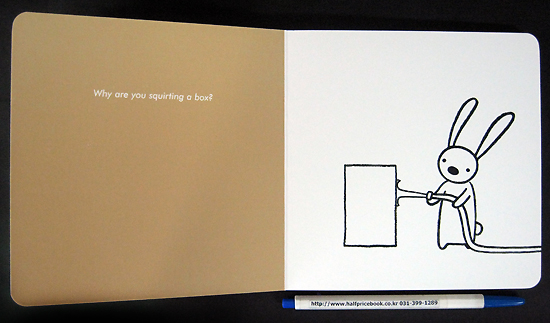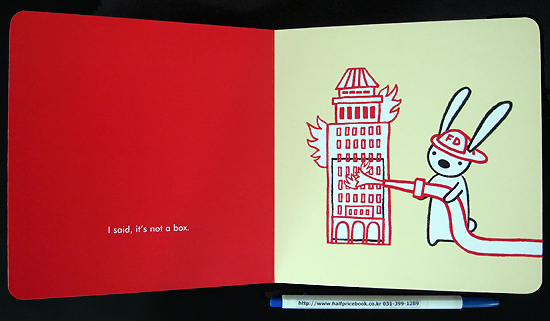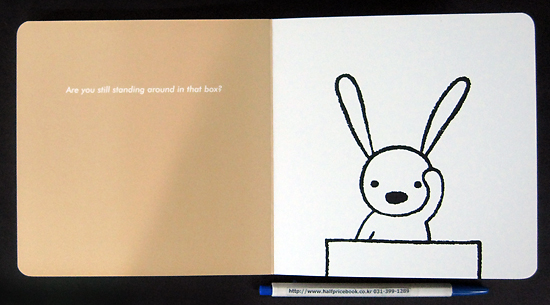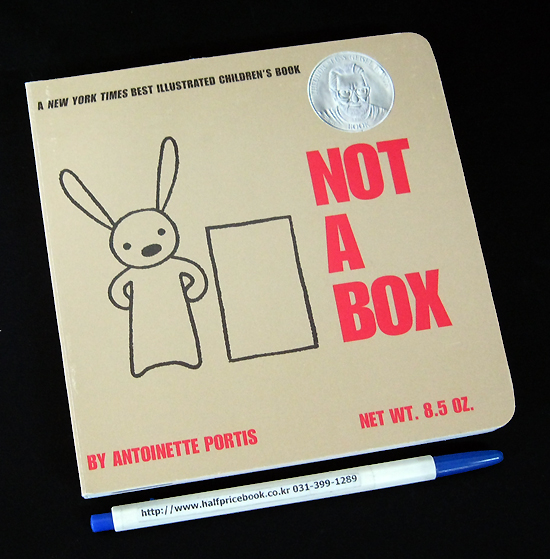|
|
|
|
 |
 이전 | 이전 |  목록 | 다음 목록 | 다음 |
|
확대 이미지 : 상세보기1

|
확대 이미지 : 상세보기2

|
확대 이미지 : 상세보기3

|
확대 이미지 : 상세보기4

|
[ 책 소개 ]
* New York Public Library's "One Hundred Titles for Reading and Sharing"
* ALA Notable Children’s Book
* Theodor Seuss Geisel Honor 수상작
* 어린이 그림책의 세계적인 베스트셀러 중 한 권입니다.
누런 골판지로 만든 튼튼한 박스. 어른의 눈에는 그저 단순한 박스일 뿐입니다. 하지만 어린 아이의 눈에는 단순한 박스가 아니지요.
박스 안에 들어간 앉은 아이에게 박스는 신나는 경주용 자동차입니다. 아이는 레이서가 되지요.
박스 위에 올라 선 아이에게 박스는 높은 산봉우리입니다. 아이는 등산가가 됩니다.
박스에 물을 뿌리는 아이에게 박스는 불붙은 빌딩입니다. 아이는 소방관이 됩니다.
박스를 옷처럼 둘러 쓴 아이에게 박스는 로보트가 됩니다. 아이는 로봇을 조종합니다.
박스는 아이의 눈에는 절대로 절대로 절대로 절대로 박스가 아니지요. 해적선의 전망대가 되기도 하고, 열기구의 바구니가 되기도 하고, 코끼리 등에 올려진 탈 것이 되기도 하고, 견인선의 조종간이 되기도 합니다.
자 이제 네모 난 구멍이 뚫린 박스가 무엇으로 보이나요? 우주를 향해 날아가는 로케트로 보이지 않나요?
왜 박스 안에 들어가 있니? 박스 위에서 뭐하는 거니? 왜 박스를 둘러 쓰고 있니?... 이런 매우 상식적인 어른의 질문에 대해 주인공 토끼아이는 자신의 상상력을 보여주는 것으로 대답을 대신합니다. 비록 단순한 종이 박스지만 아이들이 자신의 상상력을 무한히 발휘할 수 있다면, 이 세상에서 가장 좋은 장난감이 될 수 있지요.
튼튼한 보드북입니다.
[동영상]
[ 서지 정보 ]
Reading level: Baby-Preschool
Edition: Board book: 28 pages
ISBN-10: 0061994421
ISBN-13: 978-0061994425
책 크기: 15 cm x 15.2 cm
[ 영문 서평 ]
Book Description
A box is just a box . . . unless it's not a box. From mountain to rocket ship, a small rabbit shows that a box will go as far as the imagination allows.
Inspired by a memory of sitting in a box on her driveway with her sister, Antoinette Portis captures the thrill when pretend feels so real that it actually becomes real - when the imagination takes over and inside a cardboard box, a child is transported to a world where anything is possible.
Child Magazine
A child can have as much fun with a box as with the toy packaged in it. So when a rabbit imagines a box to be a burning building that he heroically douses with a fire hose and a rocket that he pilots to outer space, children will relate. This gently humorous book celebrates the ingenuity of kids, whose games of make-believe can spin magic out of the simplest materials.
Publishers Weekly
Sometimes the best toys are improvised, according to this celebration of the humble cardboard box. Packaged in a plain brown jacket that resembles a paper bag (another item with vast potential), this minimalist book features a rabbit-child, simply drawn in a heavy black line. In the first spread, designed in neutral black, white and tan, the rabbit's head peeks out of a rectangle. An offstage voice asks, "Why are you sitting in a box?" When the page turns, the rabbit answers, "It's not a box." A touch of color comes into the image. The empty white background is tinted pale yellow, and a thick red line traces a racecar over the basic black box shape, revealing what the rabbit imagines. By the time the skeptical voice inquires, "Now you're wearing a box?," readers know to expect a playful transformation in the next spread. "This is not a box," replies the rabbit, as a red robot suit is superimposed over the initial drawing. The teasing questions challenge the young rabbit, who demonstrates that a box can serve as a pirate-ship crow's nest, a hot-air balloon basket and a rocket. Readers won't abandon their battery-charged plastic toys, but they might join in a game of reimagining everyday objects. Most profitably, Portis reminds everyone (especially her adult audience) that creativity doesn't require complicated set-ups.
School Library Journal
In bold, unornamented line drawings of a rabbit and a box, the author-illustrator offers a paean to the time-honored imaginative play of young children who can turn a cardboard box into whatever their creativity can conjure. Through a series of paired questions and answers, the rabbit is queried about why he is sitting in, standing on, spraying, or wearing a box. Each time, he insists, "It's not a box!" and the opposite page reveals the many things a small child's pretending can make of one: a race car, a mountain, a burning building, a robot. One important caveat: the younger end of the intended audience is both literal and concrete in their approach to this material. The box itself, drawn as a one-dimensional rectangle, will be perceived by preschoolers to be flat and not readily understood as three-dimensional. Furthermore, those children are likely to interpret the "box's" transformation to be "magic," while five- and six-year-olds are able to make the cognitive conversion from flat rectangle to three-dimensional box and to understand that the transformation has been made by the rabbit's own imagination. Both audiences will enjoy the participatory aspect of identifying each of the rabbit's new inventions. Knowledgeable adults will bring along a large box to aid in understanding and to encourage even more ideas and play.
Booklist
Wrapped in basic, grocery-bag-brown paper, this streamlined book visualizes a child's imagined games. "Why are you sitting in a box?" reads the opening page, opposite an image of a small rabbit, drawn in the simplest, unshaded lines, who appears next to a square. "It's not a box," reads the text, presumably in the rabbit's defiant voice, on the next page, and equally simple red lines overlay the black-lined rabbit and box to show a speeding roadster. In the following spreads, the questioner (a clueless adult?) continues to ask about the rabbit's plans, while the little voice answers with the book's protest of a title. This owes a large debt to Crockett Johnson's Harold and the Purple Crayon (1955). And as in Johnson's classic, the spare, streamlined design and the visual messages about imagination's power will easily draw young children, who will recognize their own flights of fantasy.
|
| * 최근 이 작품을 구입하신 분들의 다른 선택 |
Good-Night, Owl!
An ALA Notable Book, 페이퍼백 |
Charlie and the Chocolate Factory
Roald Dahl, 페이퍼백, 미국 교사 선정 100대 서적, 슈퍼바이 |
A Mother for Choco
페이퍼백, 슈퍼바이 |
Knock Knock: My Dad's Dream for Me
Coretta Scott King Award 수상도서, 하드커버, 슈퍼바이 |
|
| |
|
|< << [1] [2] [3] [4] [5] [6] [7] [8] [9] [10] >> >|
|
|
|